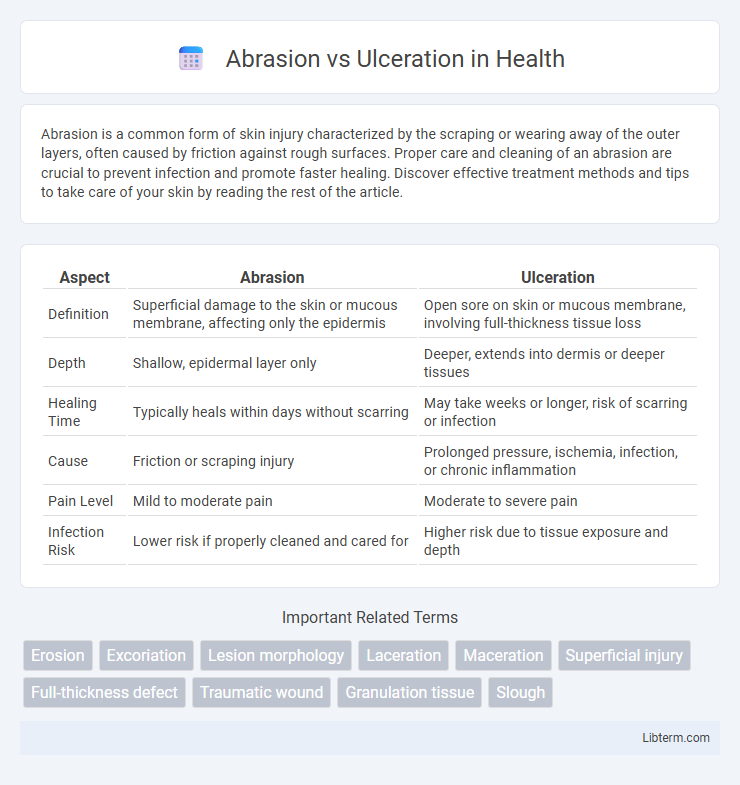Abrasion is a common form of skin injury characterized by the scraping or wearing away of the outer layers, often caused by friction against rough surfaces. Proper care and cleaning of an abrasion are crucial to prevent infection and promote faster healing. Discover effective treatment methods and tips to take care of your skin by reading the rest of the article.
Table of Comparison
| Aspect | Abrasion | Ulceration |
|---|---|---|
| Definition | Superficial damage to the skin or mucous membrane, affecting only the epidermis | Open sore on skin or mucous membrane, involving full-thickness tissue loss |
| Depth | Shallow, epidermal layer only | Deeper, extends into dermis or deeper tissues |
| Healing Time | Typically heals within days without scarring | May take weeks or longer, risk of scarring or infection |
| Cause | Friction or scraping injury | Prolonged pressure, ischemia, infection, or chronic inflammation |
| Pain Level | Mild to moderate pain | Moderate to severe pain |
| Infection Risk | Lower risk if properly cleaned and cared for | Higher risk due to tissue exposure and depth |
Understanding Abrasion and Ulceration
Abrasion refers to a superficial injury where the skin or mucous membrane is scraped or rubbed off, often caused by friction or trauma, resulting in minor bleeding and pain. Ulceration involves a deeper loss of skin or mucosal tissue, typically accompanied by inflammation and sometimes infection, leading to a crater-like lesion that heals slowly. Understanding the depth and severity of tissue damage in abrasion versus ulceration is crucial for determining appropriate wound care and treatment strategies.
Defining Abrasion: Causes and Characteristics
Abrasion is defined as a superficial injury to the skin or mucous membrane caused by friction or scraping against a rough surface, resulting in the loss of the epidermis without penetrating deeper layers. Common causes include falls, rubbing against abrasive materials, or minor trauma, often leading to redness, minor bleeding, and pain. Unlike ulceration, abrasion does not involve significant tissue necrosis or full-thickness skin loss, making it a more superficial lesion.
What is Ulceration? Key Features and Examples
Ulceration is the breakdown of the skin or mucous membrane resulting in an open sore that penetrates deeper layers, often caused by infection, chronic inflammation, or pressure. Key features include tissue loss extending beyond the epidermis, irregular margins, and the presence of necrotic or granulation tissue. Common examples of ulceration are diabetic foot ulcers, pressure ulcers (bedsores), and peptic ulcers in the gastrointestinal tract.
Pathophysiology: How Abrasions and Ulcerations Develop
Abrasions result from superficial damage to the epidermis caused by friction or scraping forces that remove the outermost skin layers, triggering an acute inflammatory response. Ulcerations develop through deeper tissue injury involving loss of the full thickness of the epidermis and dermis, often due to ischemia, prolonged pressure, or underlying chronic conditions impairing tissue repair. Cellular mechanisms in ulcerations include necrosis and impaired angiogenesis, contrasting with the primarily surface-level epithelial disruption seen in abrasions.
Common Sites for Abrasion vs Ulceration
Abrasion commonly occurs on the skin's surface over bony prominences such as elbows, knees, and shins due to frictional trauma. Ulceration is frequently observed in areas subjected to prolonged pressure and poor circulation, including the sacrum, heels, and ischial tuberosities. Recognizing these distinct common sites aids in accurate diagnosis and appropriate wound management strategies.
Clinical Signs: Differentiating Abrasion from Ulceration
Abrasion presents as a superficial disruption of the skin or mucosal surface with intact basal layers, often accompanied by redness and minimal bleeding, whereas ulceration involves full-thickness loss of the epithelium exposing underlying tissue and typically shows a well-defined wound with possible exudate. Clinical signs of abrasion include a roughened surface without necrotic tissue, while ulcers exhibit a crater-like lesion with surrounding inflammation, pain, and slower healing. Accurate differentiation relies on visual inspection of lesion depth, presence of necrosis, and characteristic tissue involvement to guide appropriate treatment.
Diagnosis: Identifying Abrasion and Ulceration
Diagnosing abrasion involves identifying superficial skin or mucosal damage that typically appears as a shallow scrape with minimal bleeding. Ulceration is characterized by a deeper tissue loss that penetrates the epidermis and dermis, often presenting with a well-defined crater and possible signs of infection or necrosis. Diagnostic techniques include visual examination, dermoscopy, and biopsy to distinguish the extent and depth of tissue damage accurately.
Treatment Approaches for Abrasions
Treatment approaches for abrasions primarily involve thorough cleaning to prevent infection and promote healing, often using saline solution or mild antiseptics. Applying antibiotic ointments and covering the wound with sterile dressings helps maintain a moist environment conducive to tissue regeneration. Pain management with over-the-counter analgesics and monitoring for signs of infection are essential components of effective abrasion care.
Management and Healing of Ulcerations
Management of ulcerations involves thorough cleaning, debridement of necrotic tissue, and application of appropriate dressings to maintain a moist wound environment that promotes faster healing. Use of topical antibiotics or antiseptics may prevent infection, while systemic treatments can be necessary for severe or infected ulcers. Healing of ulcerations depends on factors such as adequate blood supply, nutrition, and avoidance of further trauma, with chronic wounds sometimes requiring advanced therapies like negative pressure wound therapy or skin grafts.
Prevention Tips: Reducing Risk of Abrasion and Ulceration
Maintaining proper skin hygiene and moisturizing regularly helps prevent abrasion and ulceration by keeping the skin supple and less prone to damage. Using protective barriers such as bandages or padding on vulnerable areas reduces friction and pressure that can lead to skin breakdown. Avoiding prolonged immobility and ensuring good nutrition with adequate hydration supports skin integrity and promotes faster healing, minimizing the risk of developing abrasions or ulcers.
Abrasion Infographic

 libterm.com
libterm.com